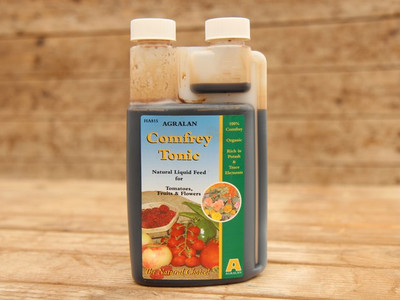How To Make Comfrey Tea Plant Fertiliser

Comfrey leaves are highly regarded as a natural and sustainable plant feed. The plant's far-growing roots enable it to extract nutrients from deep in the soil, including the the 'Big 3' plant macronutrients: nitrogen, phosphorus and potassium (or NPK).
But how best to deliver this nutritious feed to your plants? You may well have heard of 'comfrey tea'; this is where you steep the leaves to create a liquid fertiliser which will be more readily absorbable.

How To Make Comfrey Tea
Making comfrey 'tea' by fermenting leaves in water is famously smelly, which can put some people off. There is, however, an easier method that is less messy and produces very little smell. You need 2 x containers, one with a hole in the bottom and one without.
In the image we have 2 x flower pots, but you could also use large buckets if you want to make a bigger batch.

- Pack comfrey leaves into the bucket with the hole (they will break down quicker if you rip them up a bit) and weigh them down with a large stone.
- Place the full pot in the empty one below to catch the liquid that seeps out as the comfrey breaks down
- You should start to see liquid in 2 weeks, with the whole lot taking 8-10 weeks - depending on temperature and how much is in the pot or bucket.
- The nutrient rich liquid is diluted at around 20:1 (20 water to one concentrate) and can be used immediately.
The beauty of this system over the wet one is that you can keep topping up with more leaves as the level drops, for a continuous supply of plant feed.

Comfrey Tonic Liquid Plant Feed
View ProductCan Comfrey Leaves Be Used as a Mulch?
Yes - if comfrey leaves are used as a mulch, they will release their valuable nutrients into the soil as they break down. The difference is the speed at which the nutrients are released: a mulch will be slower, while a liquid tonic is taken in straight away.
Another thing to keep in mind is that comfrey is particularly high in potassium, which we want when plants are flowering and fruiting. This is when a fast acting feed will likely be more desirable than a slow release one.




